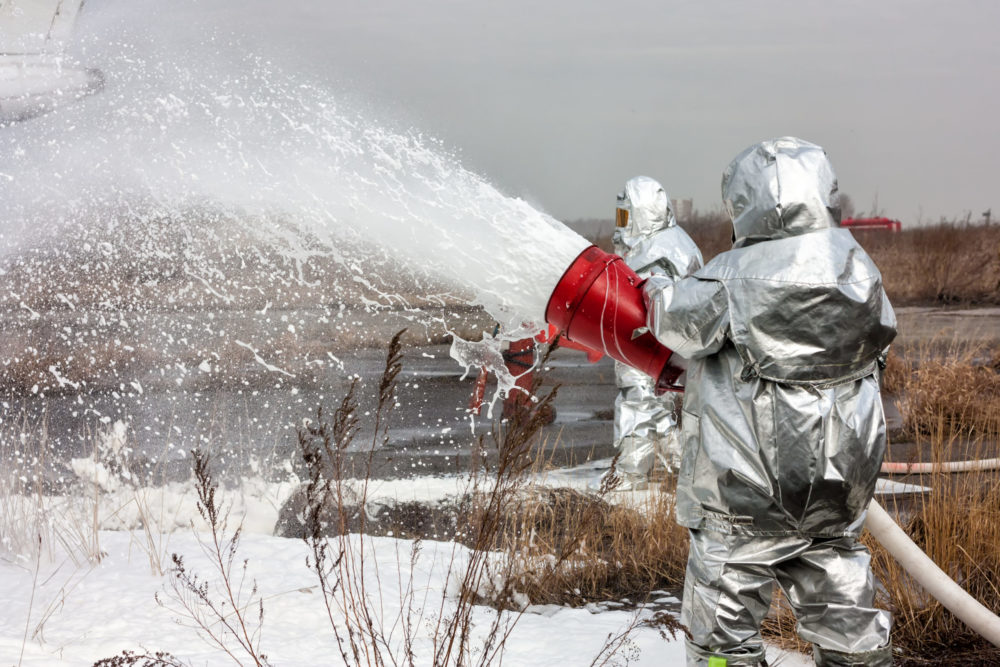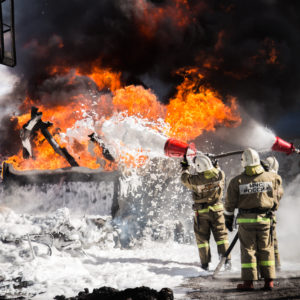Cost to Clean Up Firefighter Foam Contamination At Military Bases Could Exceed $31B: Report
The Pentagon is asking Congress for far less than is needed to clean up PFAS chemicals from firefighter foam water contamination at military bases, the report warns

A new report estimates that it will cost more than $30 billion to clean up toxic chemicals left behind by the use of firefighter foam on U.S. military bases, however, the Department of Defense has only earmarked a fraction of that cost.
According to an analysis by the Environmental Working Group (EWG) published on May 15, the cost of cleaning up contamination from per- and polyfluoroalkyl substances (PFAS) on 50 military bases nationwide is substantially higher than the $1.4 billion the Pentagon has requested.
The environmental activist organization indicates that the costs of firefighter foam contamination cleanup continue to grow, as the toxic chemicals continue to pollute military bases during training and response exercises, and even the current estimates are likely far lower than the actual cleanup costs.
Firefighter Foam PFAS Risks
Commonly referred to as “forever chemicals”, PFAS were first introduced into the manufacturing industry in the 1940’s, because of their ability to resist heat, grease, stains, and water. However, the chemicals are known to persist in the environment and human body for decades, posing a variety of serious side effects, including liver damage, thyroid disease, decreased fertility, high cholesterol, obesity, hormone suppression, and cancer.
While the chemicals have been widely used in a number of consumer products, most of the military base water contamination problems stem from high levels of the chemicals in aqueous film-forming foam (AFFF), which has been used by firefighters during training and responses exercises, which usually occur on military bases.
As a result of the poorly regulated and widespread use, PFAS water contamination lawsuits are being filed by individuals living in many areas of the U.S., claiming they developed ulcerative colitis or cancer from high volumes of PFAS chemicals being dumped into the ground water surrounding chemical manufacturing plants and around military bases, airports and other training facilities.
In recent years, hundreds of firefighting foam lawsuits have also been filed by former civilian and military firefighters diagnosed with various forms of cancer after direct exposure to the chemicals, and a number of municipal water systems are also pursuing claims against the chemical manufacturers over clean-up costs.

Learn More About
Exposure to firefighting foam chemicals may result in an increased risk of cancer for firefighters, military and airport personnel.
Learn More About this Lawsuit SEE IF YOU QUALIFY FOR COMPENSATIONAccording to EWG’s analysis, in 2021 the Department of Defense estimated that the total funding needed to clean up active, inactive and former defense sites of PFAS contamination is about $31 billion. That’s up $3.7 billion from estimates it made from 2016 to 2020.
However, for fiscal year 2023, EWG indicates the Pentagon only requested $1.4 billion for the cleanup efforts. Congress instead budgeted $2.2 billion. In its fiscal year 2024 budget request, the Pentagon has asked for only $1.5 billion; essentially asking Congress to cut its funding from the previous year.
“The department’s funding requests keep disappointing communities that are impacted by PFAS,” John Reeder, EWG’s vice president for federal affairs said. “Our analysis shows Congress must give much more funding, or the problem will keep getting worse.”
The EWG is recommending Congress allocate at least $2.75 billion in total PFAS cleanup funding for 2024, according to the analysis.
Firefighter Foam PFAS Contamination Costs Likely Much Higher
The estimated costs are based on 50 known contaminated sites, and a full estimate of PFAS cleanup at those sites was due to Congress in September 2022. The Pentagon has yet to comply, according to EWG. However, the group estimates that investigating and cleaning up firefighter foam PFAS contamination must be done at 700 known and suspected military contamination sites, which could cost tens of billions of dollars in addition to the current $31 billion estimate.
In December, EWG issued a report warning DOD was undercounting service members impacted by PFAS water contamination on military bases.
In April 2022, the DoD conducted an assessment of PFAS contamination on U.S. military bases, indicating 24 installations, with a total population of 175,000, exposed residents to PFAS in drinking water. It released the results in June. However, EWG says there are at least 116 such installations, with more than 640,000 likely exposed to PFAS in their drinking water.
EWG estimates it would take 50 years to clean up military base PFAS contamination at the current rate. The group recommends that congress provide at least $2.75 billion in total PFAS cleanup funding to the military in 2024, with $2 billion for active military sites and $750 million for former military installations which have been shut down.
Camp Lejeune Water Contamination Problems
One example of how past exposures are relevant is Camp Lejeune, a U.S. Marine training base in North Carolina, which was plagued by water contamination problems from PFAS and numerous other toxic chemicals which millions of service members, family members and other individuals were exposed to for decades.
Estimates suggest that more than a million Marines and their family members were exposed to contaminated Camp Lejeune water between the early 1950s and late 1980s, with some reports suggesting that toxic chemicals from Camp Lejeune may be responsible for more than 50,000 cases of breast cancer, 28,000 cases of bladder cancer, and 24,000 cases of renal cancer, as well as thousands of cases involve Parkinson’s disease and other health complications. It is also believed that Camp Lejeune water caused birth defects and wrongful death for thousands of unborn children exposed in utero.
For years, Camp Lejeune water injury claims have been denied by the U.S. government, based on qualified immunity defenses and the North Carolina statute of limitations, which was already expired by the time the problems at the Marine base were discovered. However, President Biden and the U.S. Congress have now opened a two year window for veterans, family members and others exposed to the water for at least 30 days between 1953 and 1987 to pursue compensation for their injuries.
A rapidly growing number of Camp Lejeune lawsuits are now filed by individuals diagnosed with various different types of cancer and other injuries. The Department of the Navy has received notice that at least 45,000 claims will be filed, and the number of lawsuits is expected to continue to grow over the next two years, before deadline to bring claims expires in August 2024.
Want a weekly update on top lawsuits, recalls & warnings?
"*" indicates required fields






0 Comments